Use the Cloud to ‘Make It Rain’
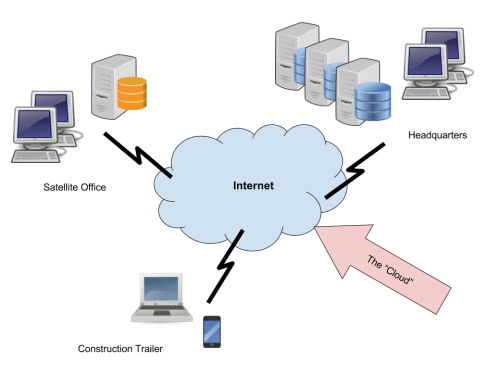
Hybrid cloud solutions provide immediate access to project data regardless of internet connectivity
Unless you’ve been hiding under a rock or locked in an abandoned MySpace chat room for the last several years, you’ve undoubtedly come across the buzz surrounding “the cloud” and how everything, including your toaster, soon will be connected to it and doing all sorts of wonderful magic. And although using the cloud to determine which bathroom stall is available in your dorm (bathroom.mit.edu) or live-translate one languange to another (translate.google.com) like a real-world Babel Fish is certainly interesting and potentially useful (especially if you live in that dorm, don’t speak the local langauge and really gotta go), there are many practical cloud applications rapidly being deployed throughout the AEC industry.
Even with widespread availability of broadband connectivity, there are times when the fastest connection still isn’t fast enough to download the massive files you need right now. And speed isn’t the only problem with remote access.

A classic WAN schematic shows the origins of “the cloud.”
CAD and BIM applications are very “chatty,” requiring a lot of back-and-forth communication between the application itself and the server where design files are stored. This results in latency issues that have plagued the industry for years. If you’ve ever worked from a satellite office or remotely on a job site, you may have experienced the frustration of trying to access a large data file only to be stymied by these issues. Fortunately, real-world solutions already on the market have been successfully deployed to make accessing data easy and painless regardless of location or internet connection speed.
What’s Cloud Computing?
Regardless of the lofty images the term may evoke, the “cloud” simply is a metaphor for the internet, with its computing and storage servers planted firmly on the ground. The term derives from the cloud-like symbol often used in WAN schematics to show hardware that’s offsite or internet based.
“Cloud computing” is storing, accessing and analyzing data with cloud-based (internet-based) resources, instead of using local workstations, servers and storage devices.
What’s a Hybrid Solution?
A hybrid cloud solution utilizes local and cloud-based resources to work with your data, allowing some tasks to be maintained in-house (e.g., archived project data) and others to reside in the cloud on internet-based resources. The cloud component of a hybrid solution can take many forms and often is a combination of one or more of the following:
Data Storage: Internet-based servers can be used to store and backup vast amounts of data for pennies per gigabyte. Examples of cloud-based data storage include Amazon Web Services (AWS) S3 or Glacier service, Dropbox and Google Drive. When data are needed, local workstations are used to download and manipulate them.
Data Analysis: The cloud portion of a hybrid system uses a vast number of CPUs/GPUs working together to solve problems that would be impossible on a typical local workstation or server. Examples of cloud-based data analysis include Autodesk Infraworks’ Watershed analysis tool, Bentley SiteOPs’ earthwork optimization tool and Panzura’s SkyBridge platform. After analysis is completed by the cloud servers, results are returned to the local application for further use in the design process.
Data Access Control and Security: A cloud-based application acts as “traffic cops and security guards,” making sure data are only accessed by the proper people as well as ensuring that data are synced and up to date across all local servers and network-attached storage (NAS) devices. Copies of the data can reside on local devices. Examples of cloud-based access control and security include Egnyte Connect and Protect services as well as the Panzura Global File System.
The Hybrid Advantage
Cloud and hybrid cloud services facilitate more than just savings on hardware purchase and maintenance costs. The near-infinite computing power and storage space provided by the cloud enables those in the AEC industry, among others, to accomplish tasks and implement workflows that would be impractical or impossible with solely local resources. Examples include the following:
• Iterative analysis for structural analysis, hydraulic and hydrologic simulation, earthwork balance optimization, and more.
• Seamless file sharing with a distributed workforce and outside partners.
• Visualization and animation rendering for complex photorealistic presentations.
• Controlled and managed central storage for internal and external users.
• Device/platform agnosticism, allowing the same data to be displayed and manipulated on a variety of devices without needing the native application that created the data.
• Services accessible from almost anywhere via mobile network connectivity.
Real-World Usage
Although all of this surely seems promising and useful, many people and potential users don’t know how or where to begin. Luckily, many industry players, large and small, already have products and solutions on the market. It’s possible you might be using some of these services without knowing it. The following are examples of how engineering and construction firms are “making it rain in the hybrid cloud.”
Adolfson & Peterson Construction Unites Sites for Improved Efficiency
Innovate. Collaborate. Outperform. These are the three words emblazoned on the homepage and marketing materials of Adolfson & Peterson Construction (AP). A commercial construction firm with offices spread across the United States and an ENR Top 100 Global Contractor, AP has more than seven decades of experience delivering exceptional projects. As many successful organizations know, you don’t get to the top without solving a few problems along the way.
The Problem
With projects throughout the United States, AP was constantly facing issues of limited connectivity and bandwidth at job sites. Onsite staff and outside teams needed access to design files, scheduling information and more.
The company was using a number of traditional forms of collaboration, including email, ftp and other third-party applications, but due to poor internet connectivity at most sites, there were huge delays in accessing the documents needed to be effective. Frustrated without a practical means to get and share files, many staff resorted to “rogue solutions,” using individual consumer products such as Dropbox or Box accounts, further exacerbating an already incoherent file-sharing process.

Egnyte Connect allows users to view building elevation plans on a tablet device.
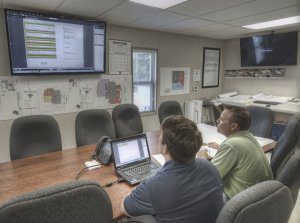
Adolfson & Peterson team members review a project schedule via shared applications on the cloud.
Furthermore, AP had no effective method to grant and control access to documents, track revisions or ensure everyone was working with the most-current files. In addition, those who needed data access weren’t using the same device or platform. Time, resources and money were being wasted, and user frustration was high.
The Solution
Due to the low bandwidth and intermittent connectivity at many job sites, Chad Herrgott, AP chief information officer, knew they would need to implement a solution that would work in a variety of connectivity conditions. After evaluating several options, Herrgott and his team decided on Egnyte Connect (www.egnyte.com) as its company-wide content collaboration solution.
“What stood out as a differentiator is the hybrid solution Egnyte provides,” says Herrgott.
Egnyte Connect integrates directly with many industry-specific applications, including AutoCAD, Bluebeam and the Microsoft 365 suite. Built on the Autodesk Forge Platform (see “Autodesk Forges Ahead,” page 27), Egnyte Connect provides downstream access to design and project files such as DWG, PDF and DOCX.
Design files can be viewed in 2D or 3D without needing the application used to create the files. For graphical files, users can view the geometry as well as access object data and make limited edits to those files. The Egnyte platform also delivers access control, which is essential for security and granting permissions to the various users. The ability to view files from any device also is a major benefit.
“Our staff and the extended team use so many different devices, and not everyone has access to the native applications used to create the documents,” notes Herrgott. “[Egnyte] Connect’s ability to display drawings, files and more on many different devices, without having to install the native app, is a huge plus for us.”
The Result
After the initial implementation of Egnyte Connect, AP saw almost immediate improvements across projects and up and down the organization.
“Overnight, the tech-support calls from project sites dropped to a fraction of what they were before the rollout,” adds Herrgott. “The end-users were much happier, because they could do their jobs much more efficiently.”
Lost productivity on the job site due to long file-open times has been eliminated. Even when internet connectivity is lost, field offices still have access to project data from their local NAS. “Instead of waiting 20 minutes for a file to open, they can now open it with the same speed users can in the office,” notes Herrgott.
AP has standardized on the Egnyte Connect platform for all projects, with more than 85 percent of its sites having an onsite NAS device that syncs with the cloud to make sure the most-current files are available and ready for use. True to its motto, through the innovative deployment of a hybrid cloud solution from Egnyte, AP can collaborate efficiently and effectively among team members in the office and at the site, enabling them to continue to perform at the highest levels.
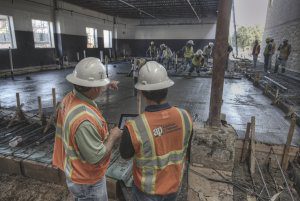
Adolfson & Peterson field crews use a tablet device to coordinate activities with up-to-date plans.
Big Red Dog Tames Explosive Growth
Founded in 2009, Big Red Dog (BRD) is a Texas-based engineering firm specializing in civil, MEP, structural, traffic and transportation engineering for real estate, infrastructure and natural-resource development on behalf of public and private clients. With a strong focus on client needs, BRD built its business around the concepts of “Service, Transparency and Quality.” Not content to stand still, BRD embarked on an ambitious growth plan, expanding from a single office to four offices, with plans to expand even further. Growth, however, especially rapid growth, can come with its share of hurdles.
The Problem
As a relatively new company with a rapidly growing staff and other resources spread across four regional offices, BRD leadership needs to utilize its technical staff regardless of where they are and where the project is located. Getting the right team together—with the proper expertise and access to the necessary project files—was not always easy.
Even with increased bandwidth among offices, it remained difficult for team members in varying offices to work efficiently on the same project files. Working with CAD, BIM and other design files, these inefficiencies in remote collaboration found their way to project bottom lines. If BRD was to continue to meet its growth targets and still deliver the exceptional service it’s known for, something had to change.
The Solution
Jason Schmidt, BRD’s IT director, set out to implement a solution that would allow BRD staff to work on CAD files across the WAN in real time, without lag or latency, so users felt like they were working on files from their office, regardless of where those files resided. His research led him to a Panzura (panzura.com) hybrid cloud solution, which uses hybrid cloud controllers in a configuration where local storage devices at each regional office cache active project data from master copies stored in the cloud. Panzura software works with a variety of cloud storage providers, and BRD selected AWS to store its data.
The solution provides BRD with a “global file system.” No matter the users’ locations, they all see the same file structure and can access the design files as if they were local. Panzura software handles file locking and syncing, maintaining file integrity and preventing unwanted duplications.
The Results
At the end of 2016, while the offices were closed for the holidays, BRD “flipped the switch,” making its new hybrid cloud solution live. Returning users were greeted with a unified file system giving them access to all the project data they need, wherever they need them. File open times across the WAN dropped from an average of nine minutes to less than one. Although they’re still getting used to the new system, Schmidt notes that user satisfaction and productivity already are on the rise.
The IT department is satisfied, too, as are the company owners. Implementing the Panzura solution resulted in the reduction or elimination of physical storage devices as well as a variety of individual online storage services.
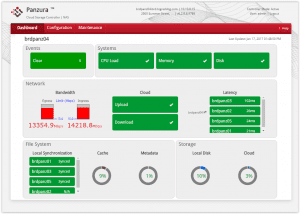
The Panzura dashboard provides Big Red Dog a high-level snapshot of the major functions of hybrid cloud storage, including connectivity to cloud storage, sync status with the cloud, controller systems and storage.
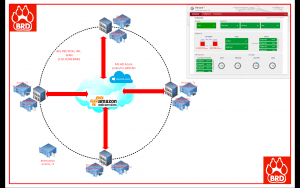
A Big Red Dog Hybrid Cloud Schematic shows its four offices and how they’re connected
through local devices and AWS cloud services.
The new system fits perfectly with BRD’s future growth strategy. “When we consider growth by either acquiring a company or opening a new office, we now have a good understanding of the IT costs associated with getting that new office up and running almost immediately,” adds Schmidt. “It’s a ‘plug and play’ solution that will grow right along with us.”
It’s Time to Act
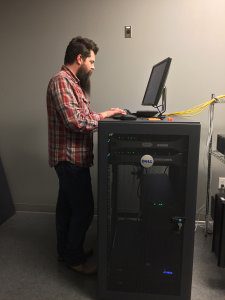
No longer just catch-phrases or buzzwords, cloud and hybrid cloud solutions are having a real impact on the AEC industry from design to construction and beyond. Organizations that put forth the effort to understand and implement these technologies will continue to have an edge over those that do not. If you haven’t already, perhaps it’s time to get your head out of the clouds, and put your data there instead.
About Mark Scacco
Mark Scacco, P.E., is a 25-year veteran of AEC technology and design consulting. He is an AEC Industry Consultant with Scacco LLC and can be reached via email at [email protected].


